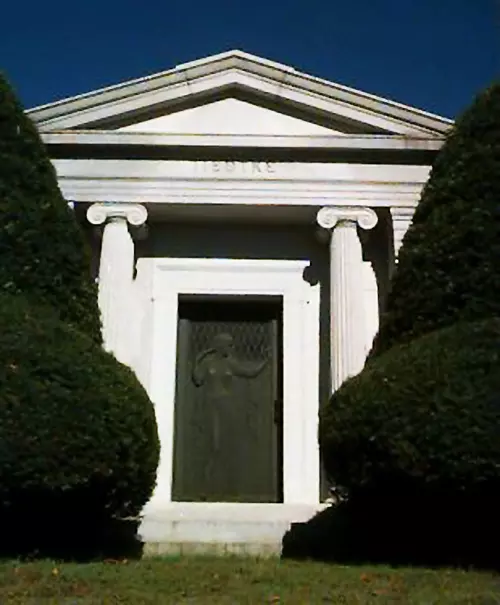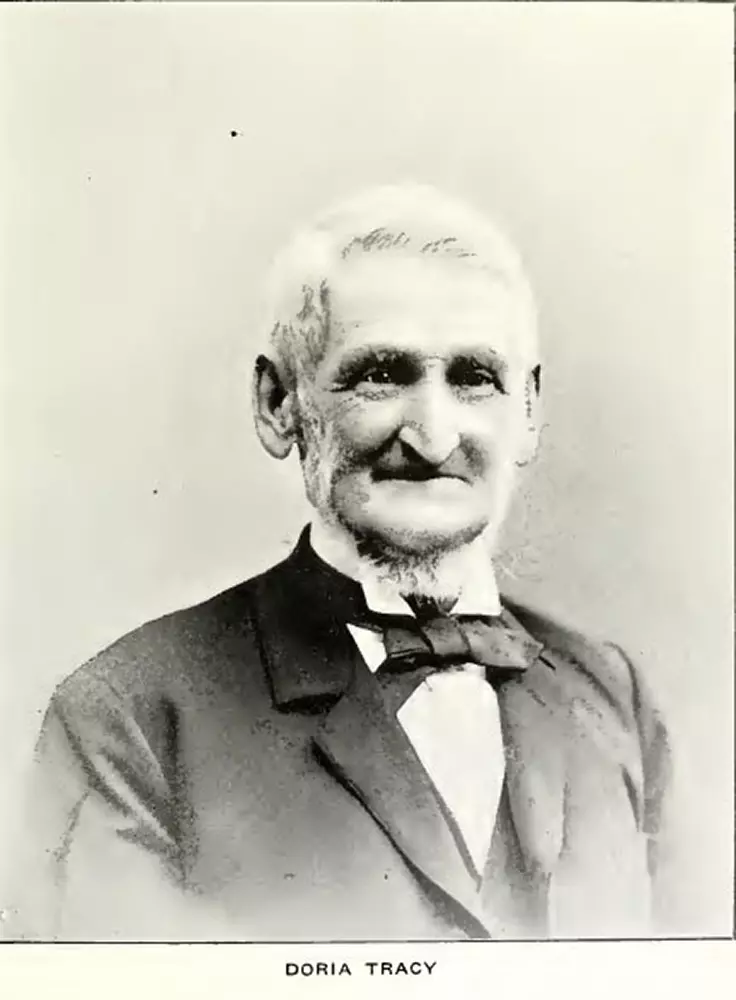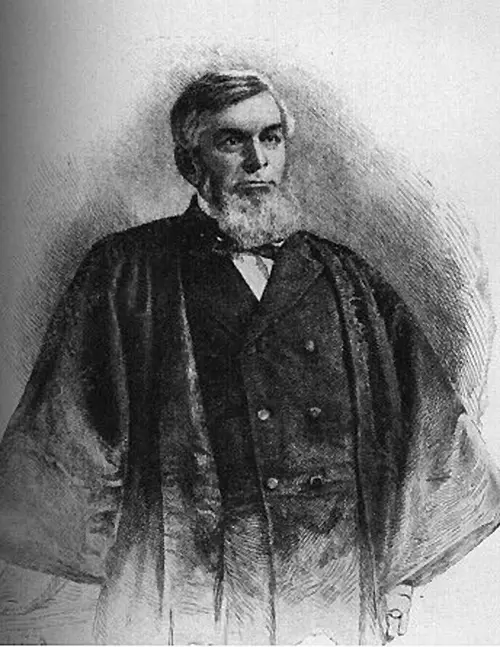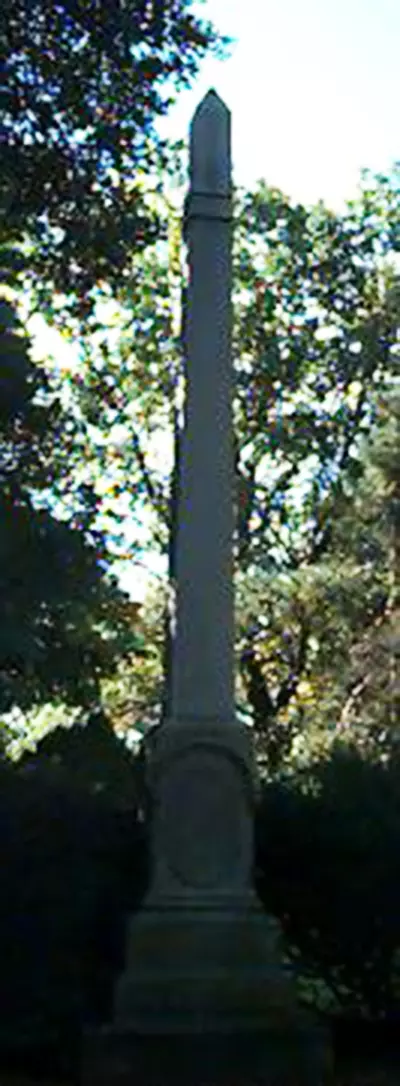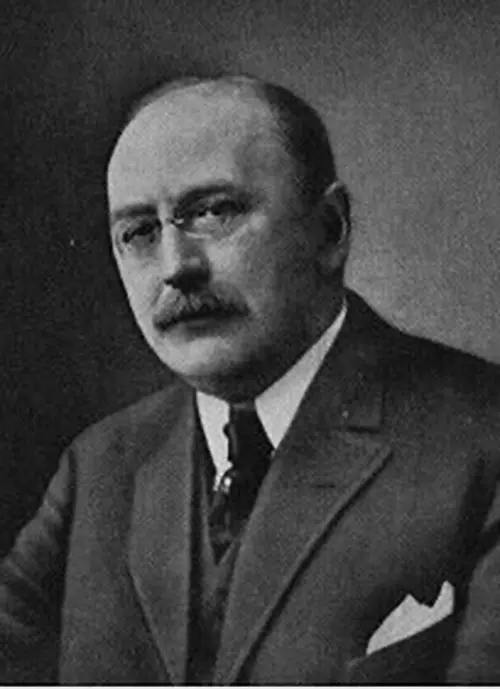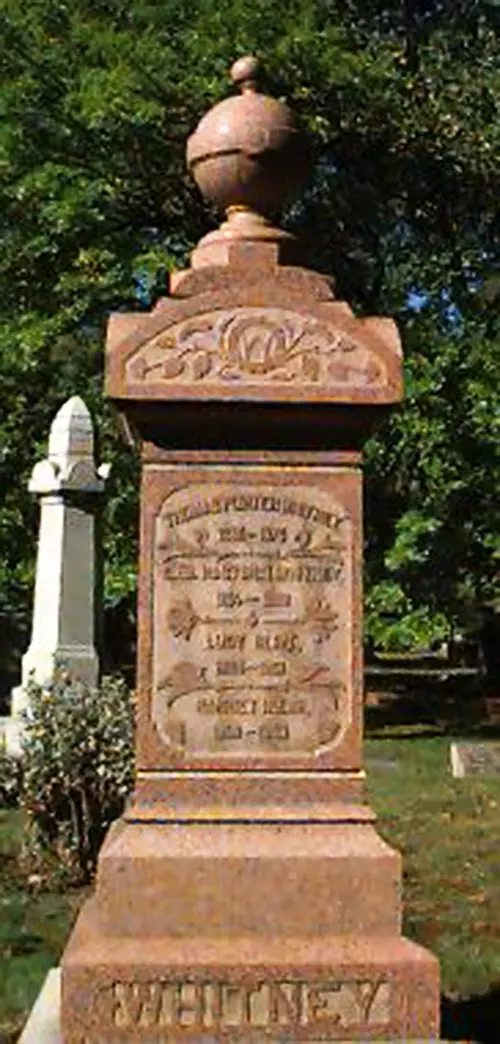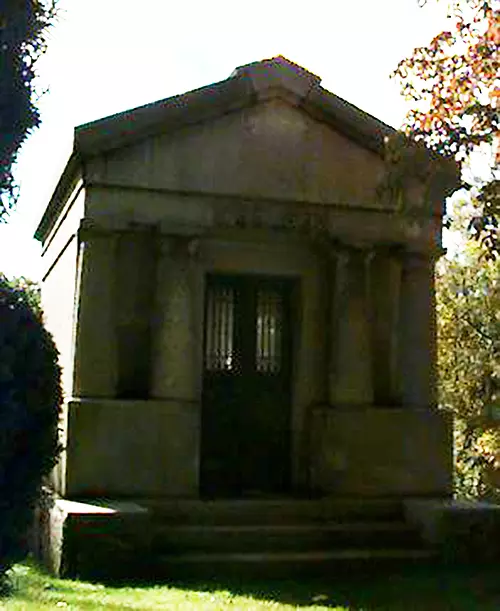The Tiedtke Brothers - Sergeant Ernst Torgler - Thomas H. Tracy - Morrison Remmick Waite - The Walbridge Family - William Spooner Walbridge - Herbert Whitney - Alvin Mansfield Woolson - Samuel Young
The Tiedtke Brothers
The Tiedtke brothers were active members of the Toledo community and during their lives experienced financial success in their business pursuits. Harry founded a printing company, while Charles and Ernest owned the well-known Tiedtke supermarket on Summit Street. The store was a Toledo institution for 79 years, and when its doors finally closed in 1972 it marked the end of an era for Toledoans.
The Tiedtke store was an innovation in the food retailing business. Instead of following in the style of specialty stores it sought to enable shoppers to buy all their needs in the one place, from bread, to produce, meat and vegetables. The Tiedtke store was also important nationally as the first supermarkets of its kind in the United States. It is widely assumed that the first supermarket was the Piggly Wiggly store which opened in 1916, in Tennessee. This was opened nineteen years after the Tiedtke store was established in Toledo. Tiedtke was also first in the development of multiple supermarket chain stores and the cash method of sales. (Victor Ullman, Tiedtkes: The First Supermarket, (1977) unpublished manuscript held at Toledo Public Library Local History Collection, p.32).
The Tiedtke store occupied seven acres at its peak and owned 130 horses with which home deliveries were made in the yellow Tiedtke wagons. An example of the innovative methods employed by the Tiedtke supermarket was their efforts to install the first air conditioning system in a food store. They did this by piping cold water from the Maumee River and Swan Creek into the meat department of the store. This helped to reduce some of the summer temperatures but proved ineffective in air-conditioning the whole store. The store finally closed in 1972 and was completely gutted by fire in 1975 dashing all hopes that the store would reopen. The store was a civic institution in Toledo and is associated with the heyday of Toledos downtown district. (Ibid., pp.4-5, 1). The Tiedtke brothers used their years of experience in the business, hard work ethics, and good nature to become one of Toledos major businesses of the twentieth century. The Tiedtke brothers also owned a chain of Thrift grocery stores. In 1924 48 of these units were sold to Krogers. (Ibid., p.14).
The brothers were born on a farm in Wood County to poor German immigrants. Their parents, August and Justine Tiedtke, emigrated to the United States in 1860 to escape the militarism that became a feature of Prussia. August was a baker by trade, but sought farm land as he hoped this would provide the kind of life he sought. After arriving in New York the Tiedtkes boarded a train that was going west. Once they arrived in Toledo August discovered that he did not have enough money to purchase the farm land he desired and instead re-entered the baking trade. In 1866 August was able to buy 15 acres of farm land in Millbury. (Ibid., p.8).
The Tiedtkes had six children, three boys and three girls. The family moved to Toledo in 1881 when Augusts health began to fail, and he died six years later of apoplexy. In his will August left each of his six children shares to the family farm, but the three boys gave their shares to their three sisters, and left the farm to find their fortunes elsewhere. (Ibid.,p. 9)
Charles was born in 1863 and was the oldest of the brothers. Ernest, the youngest brother, was born ten years later in 1873.("Civic Leader Succumbs to Pneumonia," Toledo Blade, 24 December 1928). Together the two brothers established one of Toledos landmark stores, Tiedtkes. Charles received a certificate from the Davis Business College in 1889 after completing a preliminary course in book-keeping. Before opening his own store Charles experienced twelve years of work which included six months as a bakers helper, six months cleaning up Tyron & Roud grocers, and a year of similar work at Secor, Berdan & Co. wholesale grocers. He worked for ten years at the E. G. Ashley grocer. These ten years were later recognized by Charles as the hardest years of his life. (Ullman, p.4).
Ernest was employed by an upholsterer in Toledo named Waldvogel. After a brief time there Ernest left Toledo for Boston, Massachusetts, where he believed he could find better pay. In Boston he worked for the National Casket Company but returned to Toledo in 1893 when he was nineteen years old to help his brother in the supermarket business. (Ibid., p.4). Charles and Ernest pooled their funds, equaling only $350, and used this to open their grocery business. This marked the beginning of a life-long venture.
The Tiedtke's prospered and in 1910 opened a larger grocery store at Adams and Summit. They continued to add clothing, furniture, and other merchandise to their store which eventually expanded into a department store. The Tiedtke store featured pipe organ concerts during the day and was known for its efforts to make shopping a pleasurable experience.("Ernest Tiedtke, Once Farm Boy, Became Store Co-Owner," Toledo Blade, 3 February 1950). Their business grew until they had opened 65 thrift stores in addition to their Toledo department store.
Charles and Ernest became known for traveling on different trains when they wintered in Florida. The reason for this was Charles's idea that if one of the Tiedtke brothers was killed in a wreck, there would still be one left to run the business. When the two brothers retired in 1925, they sold the Tiedtke store for $4 million. This was the largest business transaction in Toledo up to that time.
Charles was known for his gifts to the Toledo Zoo and for his quiet, generous donations to the city's poor.("Charles Tiedtke Succumbs After Pneumonia Attack," Toledo News Bee, 24 December 1928). After the Tiedtke department store was sold he still visited his oldest employees at the store. Charles died of pneumonia on December 24,1928.("Civic Leader Succumbs to Pneumonia." "Tiedtke Will Leaves Gifts To Relatives," Toledo Blade, 31 December 1928).
Ernest Tiedtke was a director at Woodlawn Cemetery and Toledo Trust Company. As president of the Tiedtke Realty Co. he was one of the largest real estate holders in Toledo. Ernest Tiedtke was a member of the Rotary Club, Inverness Club, Toledo Club, and the Toledo Country Club. After selling the store Ernest, as Charles was, could be seen visiting old employees and wandering through the store. Ernest Tiedtke was married to the former Mamie Meyer. He died on February 3, 1950.("Ernest Tiedtke, Once Farm Boy Became Store Co-Owner." "Ernest Tiedtke Rites to be Held Here," Toledo Times, 4 February 1950).
Charles and Ernest Tiedtke's brother, Harry, achieved prosperity in the printing business. Harry Tiedtke was born on November 12, 1870. After graduating from Toledo public schools he became a printer's apprentice at the B.F. Wade Company.[Charles S. Van Tassel, ed. Harry E. Tiedtke. The Story of the Maumee Valley, Toledo and the Sandusky Region, vol. 3 (Chicago: The S.J. Clarke Publishing Company, 1929), p.547]. As a young man he was a member of the Orlo Male Quartet which achieved a small amount of fame. At the age of twenty he was one of the founders of the Van Wormer & Tiedtke printing company. The company name was changed to the Harry Tiedtke Printing Co. when he bought out his partner.(Van Tassel, p.347). After his business became successful Harry also invested in valuable downtown properties.
Harry Tiedtke became renowned in Toledo for his church and philanthropic work. He was an avid supporter of the Sunday school movement and for 33 years he was the superintendent of the First Westminster Presbyterian Church Sunday school.("Death Calls Harry Tiedtke," Toledo Blade, 7 July 1924). He was also on the managing board of the Toledo Sunday School Association (TSSA). He loved the children so much that when he went on vacation he often sent them postcards. During W.W.I, Harry Tiedtke helped pay for bibles that the TSSA sent to soldiers.(Van Tassel, pp.547-548). His work with the Sunday schools also extended to the American Sunday School Union.
Harry Tiedtke worked for better social and living conditions in the city of Toledo. He was a member of the anti-saloon league and worked with John E. Gunckel to establish the Toledo Newsboys' Association. Harry was also an organizer of the Toledo City Mission. He and his wife had one daughter, Justina. Mrs. Tiedtke died in 1917, while Harry Tiedtke died of pneumonia related heart failure, seven years later, on July 22, 1924.("Death Calls Harry Tiedtke.")
Sergeant Ernst Torgler
Sergeant Ernst Torgler was born in Germany in 1840 to Ernest and Agusta Torgler, In 1852 his parents emigrated to the United States. The Civil War broke out in 1861 and the following year Torgler enlisted in the Army. He began as a private in Company G of the 37th Ohio Volunteer Regiment.[Portrait and Biographical Record of the City of Toledo and Lucas County. (Chicago: Chapman Publishing Co., 1895), p.422]. The regiment consisted mostly of German immigrants from Toledo, Cleveland, and Chillicothe.(Toledo Blade, 26 May 1991).
The first action Torgler saw was the siege of Vicksburg in June and July of 1863. Torgler was promoted to corporal following the Union victory in Vicksburg. By the end of the war, Torgler would be a sergeant. In the fall of 1863, he wore the colors at the Battle of Mission Ridge in Chattanooga, Tennessee. The following year he was with General William Tecumseh Sherman on the Atlanta Campaign in the Summer of 1864. He received the Congressional Medal of Honor for his service at the Battle of Ezra Chapel on July 28, 1864. While his regiment was retreating, he charged through sheets of bullets to rescue Major Hipp. The Major was shot off his horse and was at risk of being captured. Sergeant Torgler saw the danger and saved Major Hipp. Sergeant Torgler was awarded the Medal of Honor for action above and beyond the call of duty.
The war ended in 1865 and three years later Torgler married Augusta Schracker. They were the parents of eleven children. Ernest Torgler was a member of the Grand Army of the Republic. He lived out his life as a farmer in Point Place, Michigan and died in 1923. He is buried at Woodlawn Cemetery.
An interesting postscript is that it was not marked on Torgler's grave that he received the Congressional Medal of Honor. In 1991, the Army rectified this situation with a presentation on Memorial Day. Congressional Representatives, senators and other dignitaries attended. His great-grandson, George Jackson of Grosse Point, Michigan, now holds his great-grandfather's medal.(Portrait and Biographical Record, p.422).
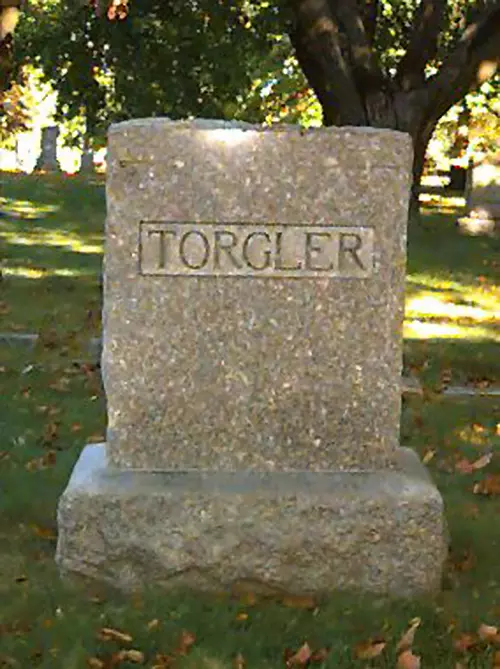 Sergeant Ernst Torgler's grave
Sergeant Ernst Torgler's grave
Thomas Henry Tracy*
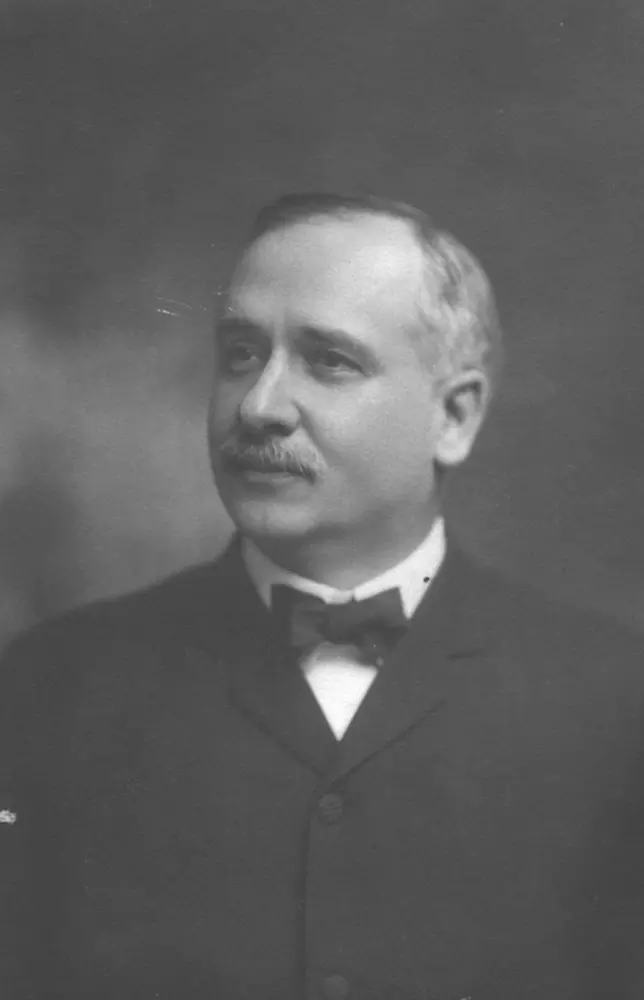 Thomas Henry Tracy (Source: Larry Leach)
Thomas Henry Tracy (Source: Larry Leach)
Thomas Henry Tracy was born in Bowling Green, Ohio, July 13, 1859, to Joseph Rex and Hanna (Burdick). Tracy received his primary and secondary education in Bowling Green public schools and attended Normal College in Mansfield, Ohio. He studied law at the firm of Bissell & Gorrill and was admitted to the Ohio Bar in 1883. Eventually, Bissell & Gorrill made Tracy a partner and he remained with the firm for ten years.
On April 1, 1892, Tracy entered into a partnership with Harry E. King. The firm of King & Tracy practiced both general and corporate law in all of the courts in northern Ohio. King retired in April of 1914 and Tracy became senior partner at Tracy, Chapman & Welles, the largest, most prominent law firm in Toledo in the late nineteenth and early twentieth centuries.
Tracy took a special interest in the growth of Toledo's cultural, economic, political and educational institutions. He served as director and attorney for the Toledo-Edison Company, and the Toledo & Indiana Railway Company. He was a member of the Toledo Board of Education and he assisted the Toledo Republican Party. In 1889 Tracy accepted an appointment as a trustee for the Natural Gas Department of Toledo where he participated in the planning and construction of the city's natural gas plant.
Tracy married Laura E. Pratt of Weston, Ohio, on January 1, 1885 and the couple had five children. Thomas H. Jr., born June 15, 1890 in Toledo, attended high school in Asheville, North Carolina and then the University of Michigan. He later became president of Tracy Auto Sales Company, a distributor of cars.
Thomas H. Tracy, Jr. went to work for the Toledo Screw Products Company. During World War I he was engaged in government work in connection with the manufacturing of munitions. He became the vice-president of Airway Electric Appliance Company, a manufacturer of vacuum cleaners and electric motors. In 1921, he became the district agent for the Earl & Stevens Motor Cars. He eventually built up a large sales organization and became the sole agent in his district for the cars. He organized his business under the name of Tracy Sales Co., Inc.
Tracy married Bess Whitaker of Toledo and the couple had three children. Bess died in 1919. He was remarried to Ruth Haviland on May 10, 1920. Tracy died September 9, 1929 at the age of 39. His father died December 27, 1933 at the age of 74, and his mother died October 9, 1952.[John M. Killits, ed., Toledo and Lucas County, Ohio 1623-1923, vol. 3 (Chicago: S.J. Clarke Publishing Co., 1923), pp.96-97; Charles S. Van Tassel, ed., Men of Northwestern Ohio (Toledo: Hadley Printing Co., 1898), p.31; and Charles S. Van Tassel, The Story of the Maumee Valley, Toledo, and the Sandusky Region (Chicago: S.J. Clarke Publishing Co., 1929), pp.613-614].
* This image was changed on a correction submitted by Mr. Larry Leach (a great-grandson of Thomas Henry Tracy). The previous image showed Doria Tracy (shown below). Toledo's Attic apologizes for this error and the inconvenience it may have caused.
Morrison Remmick Waite
Morrison Remmick Waite was born in Lyme, Connecticut on November 27, 1816. His father, Henry Matson Waite, served as the Chief Justice of the Connecticut Supreme Court of Errors. Morrison Waite spent his childhood days in a village schoolhouse learning the basics of Webster's Spelling Book and Murray's Grammar. Long school hours ended with carefree summers on his family farm or the farms of his grandfathers.[C. Peter Magrath, Morrison R. Waite: The Triumph of Character (New York: The Macmillan Company), pp.24-27].
Morrison spent a year studying Greek and Latin at Bacon Academy, one of the best private schools, while he applied for admission to Yale University. Upon passing the exams, Waite joined 125 other men as Yale's Class of 1837. One of Waite's classmates commented on his character:
Never rhetorical and never ostentatious, he was from the beginning until his graduation a most intelligent, a most faithful, and a most successful student, having always the respect of all in these qualities, and not less in the sobriety of his conduct and dignity of his character.(Ibid., p.29).
Morrison Waite graduated in the summer of 1837 and returned to Connecticut to read law with his father. Although fascinated with the subject, Waite found little adventure in Connecticut and turned toward the frontier area to satisfy his ambitions. Attracted to the Western Reserve area, Waite set out to visit his uncle, Horace Waite, who worked in Maumee, Ohio as a merchant.(Ibid., pp.30-33).
Originally, Waite intended to travel all the way to Michigan. But by late 1838, he decided to settle in Maumee where he found employment with Samuel Young, a lawyer who had arrived in the area a few years earlier. Young and Waite established a successful law practice and worked closely together as colleagues and as friends.(Ibid., pp.36-37). In 1850, Waite moved to Toledo to open another office. Shortly after, Young decided to leave the law practice in pursuit of business and banking interests. Morrison Waite's brother, Richard, joined the practice and the name consequently changed to M.R. & R. The practice continued to serve the Toledo area for approximately eighteen years.(Toledo Biography Scrapbook, Local History Room, Toledo Lucas County Public Library).
Waite ventured into other areas of political life. He served as Maumee's mayor in 1846 and as a member of the Ohio Legislature in 1849, representing the Whig Party. Between 1871 and 1872 Waite received the honor of being a member of the counsel for the United States in the Alabama claims dispute with Great Britain. The trial took place before the arbitration commission in Geneva, Switzerland.(Ibid).
Morrison Waite's involvement with the case in Geneva led to his nomination for Chief Justice of the U.S. Supreme Court by President Ulysses S. Grant on March 4, 1874. Waite accepted the nomination and replaced the deceased Salmon P. Chase on the high court. Waite remained on the bench for fourteen years and was most noted for his decisions involving Chinese exclusion, polygamy, and the right of the states to prohibit the liquor traffic. Waite participated in over 1,000 decisions made by the Court. He is possibly most noted for writing the majority opinion in the acclaimed case of Munn vs. Illinois (1877) which set the precedent for the Granger cases and eventual establishment of the Interstate Commerce Commission. While on the bench, Waite declined a bid to run for the presidency and also an appointment to the electoral commission designed to resolve the disputed 1876 Hayes-Tilden presidential election.(Ibid).
Dedicated to his position on the Supreme Court, Waite nevertheless avoided the formalities and fancy lifestyles of Washington society. Waite found great pleasure in returning to Toledo and to his old friends, the "Maumee pioneers". Waite once commented:
As I get farther and farther away from our early years on the Maumee, the pleasures of meeting with those I knew increase. Aside from that too, it is pleasant to hear the old stories of the old times repeated and to live over in imagination the life we there led.(Magrath, p.307).
On March 23, 1888, Supreme Court Chief Justice Morrison R. Waite died after being stricken by a severe case of pneumonia. Crowds of people gathered and formed a memorial procession when his body arrived in Toledo from Washington. Morrison Waite was laid to rest at Woodlawn Cemetery beneath a stone that deeply reflected his character: simple and honest. Enduring memorials to Waite in the Toledo area include Waite High School.(Toledo Biography Scrapbook).
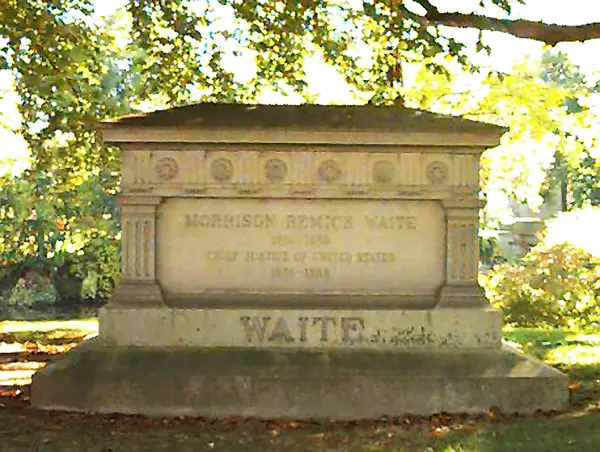 Morrison Remmick Waite's grave
Morrison Remmick Waite's grave
The Walbridge Family
The Walbridge family was influential and powerful in the mercantile, banking, and transportation businesses of Toledo. The first Walbridge to leave his mark on Toledo was Horace S. Walbridge. He was born on July 21, 1828 to Chester and Mary Walbridge in Syracuse, New York. When he was three the family moved to Columbus, Ohio. In 1834, they moved to Port Lawrence, which eventually became Toledo. The familys poverty prompted Horace to become self-supporting at the age of 12. His first job was as a clerk for merchant Stephen Marsh and over the following years he was employed as a clerk in other stores. Horace superintended the construction of a sawmill in Ottawa Lake, Michigan in the winter of 1845-1846.("Horace Walbridge Dead", Toledo Blade, 31 January 1893). In the spring, he took a large cargo of straw hats to Cincinnati on the canal.
In 1846, Horace Walbridge was employed by the forwarding and commission agent Thomas Watkins. When Watkins died in 1852, Horace took charge of P. Buckingham & Co. Walbridge was on a salary of $1000 a year and at the end of 1852, he became a firm member. In 1857, the company closed and he became a partner in the commission house of Brown, Walbridge & King. Eventually , his partners left and his brother Ebenezer joined him. The firm then changed its name to H.S. Walbridge & Co.[Horace S. Walbridge. Portrait and Biographical Record Of The City of Toledo and Lucas and Wood Counties (Chicago: Chapman Publishing Co., 1895), p.383). At the beginning of the Civil War, Horace Walbridge helped fund General James Steedmans regiment.("Republican Candidate for Mayo"r, Evening Post, 3 April 1895). His company went out of business in 1868, but by that time he had been involved for three years with the Chicago business of Walbridge, Watkins & Co. Horace Walbridge left that firm because he was involved with new areas of the business.[John M. Killits, ed. 1923. Toledo and Lucas County, Ohio, 1623-1923. vol. 3 (Chicago: S.J. Clarke Publishing Co., 1923), p.511].
Horace Walbridge was president of the Toledo and Woodville railroad from 1869-1874. He was also known as a financier having been president of Northwestern Savings Bank. Walbridge was also a vice-president at Toledo National Bank and served on the board of Northern National. Horace Walbridge was the first president of Woodlawn Cemetery in 1877. In that year a new H.S. Walbridge Co. was formed with his son Thomas.(Portrait and Biographical Record). He owned hundreds of thousands of dollars worth of land in Toledo, California, Wisconsin, Missouri, and Kentucky. His investments helped found such companies as Maumee Rolling Mills and the Gendron Iron and Wheel Co.
Horace Walbridge was known for his quiet anonymous philanthropy. He would find the name of a deserving family and give them a check for $25, $50 or $100. Walbridge gave the poor families of Toledo wood, coal, and food. In his office vault there were mortgages with unpaid interest that he could have foreclosed.
He at one time had been a member to the Toledo city council, and a president of the Toledo Society for the Suppression of Vice. On October 18, 1854 he married Isabella Watkins and was the father of five children. Horace S. Walbridge died on January 31, 1893.Horace Walbridge Dead.
Thomas H. Walbridge was the son of Horace. He was born around 1855 and was educated in the Toledo Schools. In 1876, he received a civil engineering degree form Rensselear Polytechnic. He was founder and the president of the Toledo Savings Association for more than 32 years. He owned and developed the Walbridge Farm Dairy Co. They were one of the first companies to supply bottled milk in northwest Ohio. He was president of the board of trustees at Woodlawn Cemetery. Thomas Walbridge was president of the park board. He helped defeat objections to the bond issues that created Riverside, Ottawa and Walbridge parks. In 1924, Thomas retired from Horace Walbridge and Company. Thomas Walbridge was married to Mary Young and they were the parents of Stanley and Thomas. After Mary died in 1899, he married Irma Logan and they had one child, Katharine. Thomas H. Walbridge died on August 9 , 1934. ("Toledo Civic Leader Dies", Toledo Blade, 10 August 1934). ("Thomas H. Walbridge", Toledo Blade, 10 August 1934).
Mrs. Elizabeth Walbridge was the wife of Silas Cornell Walbridge. Silas was the son of Ebenezer R. Walbridge, and a vice-president of the Berdan Company.("Death Takes Noted Toledo Businessman", Toledo Blade, 14 April 1930). Mrs. Walbridge was born Elizabeth Cummings in Toledo during the year 1870. She looked after the welfare of the community. In 1908 she was named president of the District Nurse Association. When World War I began, she and other women organized to sew bandages for French relief. In 1916 she organized the Toledo chapter of the Red Cross. Five years later she became Toledos first Christmas mother. As Christmas mother she was chairman of the general Christmas committee. Mrs. Walbridge worked with churches, philanthropic, social and fraternal organizations to provide clothing, toys and dinners to the needy.("Mrs. S. Cornell Walbridge Outstanding in Welfare and Social Work", Toledo Blade, 11 April 1949).
Mrs. Walbridge was well known for her collection of autographs and first editions. She was the owner of a signed order of Napoleon Bonaparte and a Benjamin Franklin autograph. Her collection also included a copy of Henry Wadsworth Longfellows poem Excelsior written in his handwriting. She was also in possession of the autographs or letters of Ralph Waldo Emerson, Thomas Moore, Nathaniel Hawthorne, Mark Twain, Joseph Conrad and others.("Mrs. S. Cornell Walbridge Assists Essayist And Critic", Toledo Blade, 5 May 1934). Elizabeth Walbridge died in April 1949.("Mrs. S. Cornell Walbridge Outstanding in Welfare And Social Work").
William Spooner Walbridge
William Spooner Walbridge was the president of the William S. Walbridge Co. and the Kent-Owens Machine Co. He was born in Boston, Massachusetts on September 19, 1854. His father Levi was a partner in a furniture company. He attended the Boston public schools while he worked at his father's firm. After the death of their father, William and his brothers took over their father's part of the firm. William was senior partner in the company known as Walbridge and Briggs. He was a prominent businessman in Boston, but in 1898 moved to Toledo to become the treasurer of the Toledo Glass Company. He later became treasurer and vice-president of the Owens Bottle Machine Company.[John M. Klllits, ed. Toledo and Lucas County, Ohio, 1623-1923. vol. 2 (Chicago: S.J. Clarke Publishing Co., 1923), p.69]. With Michael Owens and Edward Libbey, William S. Walbridge developed the glass making machine. He later became president of Kent-Owens which manufactured the machines.("W.S. Walbridge Rites to be Held Tomorrow," Toledo Times, 24 November 1935).
William S. Walbridge was a director of the Northern National Bank and of Citizens Safe Deposit and Banking, Co. He was also a director at the Collin-Norton Company. He later founded his own investment firm, the Williams. Walbridge Co.("Industrial Leader Dies," Toledo Blade, 24 November 1935). In 1927 he resigned as chairman of the board at Owens Bottle Co. He still continued to serve on their board of directors.("William S. Walbridge," Toledo News Bee, 23 November 1935).
On October 25, 1882, William S. Walbridge married Alice Langdon Libbey who was a sister of Edward Drummond Libbey.Harvey Scribner, ed. 1910. [Memoirs of Lucas County and the City of Toledo, vol. 2 (Madison Wis: Western Historical Association, 1910), p.109]. He owned a collection of ancient and modern glass containers, flasks, and bottles. He authored a book on bottles titled American Bottles: Old and New.("Industrial Leader Dies," Newspaper transcript in Toledo Biography Scrapbook Local History Room, Toledo-Lucas County Main Library). He was also known as a charitable man who passed on his wealth wherever he could.("William S. Walbridge," Toledo Times, 26 November 1935). Walbridge was a trustee and president of the Convalescent Home for Crippled Children. He became personally acquainted with many of the children at the Charles Feilbach School for Crippled Children.("W.S. Walbridge Rites to Be Held Tomorrow.") Over his lifetime groups such as the Toledo Society for Crippled Children, the Toledo Society for the Blind, the YMCA and the YWCA received his generous donations.("Value of W.S. Walbridge Estate More than $60,000," Toledo Blade, 3 December 1935).
His civic interests included being a member of the Anthony Wayne Chapter of the Sons of the American Revolution, the Toledo Country Club, and the Rotary Club.("W.S. Walbridge Rites to be Held Tomorrow.") William Spooner Walbridge died on November 23, 1935 at the age of 81.("Industrial Leader Dies.") His wife Alice had preceded him in death.
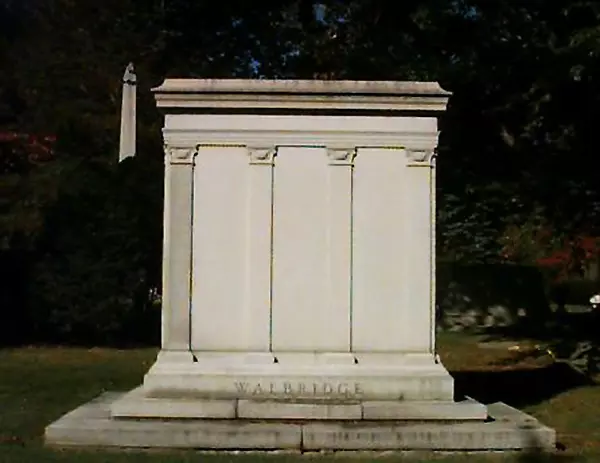 William Spooner Walbridge's grave
William Spooner Walbridge's grave
Herbert Whitney
Herbert Whitney, born in Toledo in 1877, was a descendant of Noah Ashley Whitney who came from New England in 1824, one of the original settlers in Toledo. For much of Toledo's history, the farm land in the Monroe-Collingwood area was owned by the Whitney family, hence the name of Whitney Avenue. It was here that Herbert Whitney was born in a farmhouse.
Whitney attended the old Toledo High School, playing football for two years. He went on to graduate with a Bachelor's Degree from Amherst College in 1899 and then continued his education at the law school of the University of Michigan. Whitney played catcher on the baseball team there, a team that won the Western Conference championship in 1900. He earned his law degree in 1902 and returned to Toledo to start a practice.
Once in Toledo, Whitney's interests broadened. He coached the Toledo High School football team from 1902 to 1905. He also actively pursued political interests. He was involved with the Independent movement started by Samuel (Golden Rule) Jones. At age 28, he was even elected to the municipal bench. Serving only a single term -- it is amazing that he was forever regarded as Judge Whitney. Herbert Whitney proudly supported Theodore Roosevelt in 1914 and attempted to gain a United States Congressional seat on the Progressive ticket, but he was defeated.
In 1914, Whitney married Louise Metzger and immediately began to devote his energies to his family and the church. He gave up politics and concentrated on the development of his father's farm land. Portions of the land were transferred to the city and later became Jermaine Park. The rest was subdivided into Whitney Hills.
Whitney was a member of the Monroe Street Methodist Church. He founded a Sunday school program for high-school boys and also taught it for nearly fifty years. He served as a chairman of the Church's board and head of the pastoral relations committee. Whitney also led building programs for the church in both 1925 and 1955.
Aside from these activities, Whitney never gave up his love for sports. He actively participated in swimming, handball, and bowling. He teamed up with Dr. Henry Paine to win the tennis doubles championship of Toledo in 1913. He played golf several times a week at the Sylvania Country Club. Whitney traveled extensively through the United States and made four trips to Europe, including one to Russia in 1952. Herbert Whitney spent much of his time with groups like the Sons of the American Revolution, the YMCA, the Masons, and he was member of the Toledo and Ohio State Bar Associations. He also served as treasurer of the Whitney Hills Realty Company, the Moncroft Realty Company, and the Old Town Realty Company as well as president of the Toledo Stove and Range Company.
Mr. Herbert Whitney passed away on March 21, 1957 in his home. Surviving him were his wife, Louise, and their two children, Mrs. Mary McKenny of Toledo and Thomas Whitney, an Associated Press Correspondent. Louise Whitney passed away in 1980 at the age of ninety-five.(Toledo Biographical Scrapbook, Local History Room. Toledo Lucas County Public Library). (Article from The Toledo Blade on the Whitney family).
Alvin M. Woolson
Born in Erie County, Ohio on October 2, 1841, Alvin Mansfield Woolson was one of Toledo's most successful and respected citizens. Woolson's family is one of old American stock. His ancestor, Joseph Woolson came to America from Canterbury, England in 1630 and settled in Massachusetts. The Woolson family eventually came to northern Ohio where Alvin was born and raised.
Woolson received his early education in the noted "Country Schoolhouse on the Hill" and often found employment with printing presses and on the farms. With the outbreak of the Civil War, Woolson enlisted in the Union Army: Company M, First Regiment, Ohio Volunteer Heavy Artillery. He served between 1862 and 1865 achieving an impeccable record and a promotion to Sergeant-major.
At the conclusion of his military service, Woolson heeded the call west and found a job as an accountant with the Union Pacific Railway, Eastern Division. A year and a half later, Woolson returned to Ohio and became a merchant in both Berlin Heights and Wauseon. On October 12, 1870 he married Miss Frances D. Tillinghast and they had three children.
In 1875, the Woolsons moved to Toledo. Alvin wanted to start a coffee and spice company but lacked the necessary capital. Therefore, he started his own grocery business. In 1882, however, Woolson became interested in the C.C. Warren & Company, coffee roasters and spice dealers. They were experiencing financial difficulties. Woolson convinced fellow wholesale grocers to become stockholders under his management and bought out the C.C. Warren & Company. Pliny Watson, stockholder and grocer, suggested that the company be renamed the Woolson Spice Company. Its list of stockholders included many prominent Toledo names: Watson, Emerson, Ketcham, Secor, Berdan and Wood.
The Woolson Spice Company prospered, and becoming the second largest coffee company in the world. Woolson had virtually revolutionized coffee merchandising by roasting and grinding the beans. In 1897, Woolson sold the company to H.O. Havemeyers of New York City and retired a few months later.
Retirement, however, did not slow Alvin Woolson down. He traveled extensively. Woolson was also considered "one of Toledo's public-spirited citizens." He served as a director in the Second National Bank, the Northern National Bank and was a founder and director of the Union Savings Bank. Proud of his service during the war, Woolson was an active member of a number of societies such as the Society of Colonial Wars, the Grand Army of the Republic and the Toledo Soldier's Memorial Association. The Toledo Country Club, the Toledo Art Museum, and the Toledo Newsboys' Association also listed Woolson as a member. He organized the citizens committee that brought Libbey Glass to Toledo and suggested the development of the Chamber of Commerce.
Toledo felt a great loss in 1925 when Alvin Mansfield Woolson died.[John M. Killits, Toledo and Lucas County, Ohio 1623-1923, vol. 2 (Toledo: S.J. Clarke Publishing Company, 1923), pp.513-516].
Samuel Young
Samuel Young, a pioneer in the Toledo area was originally a native of Lebanon, New Hampshire, where he was born in 1806. Young grew up in Lebanon and attended the local schools there. He decided on a legal career at an early age, and, after completing his education, Young read law with John M. Pomeroy of Burlington, Vermont. After Young obtained admission to the bar, he traveled to the frontier and settled in Maumee, Ohio.
In 1835, Young established a law office in Maumee and three years later took Morrison R. Waite as a partner. Waite eventually went on to be the Chief Justice of the Supreme Court of the United States. The two opened an office in Toledo in 1850. Young remained with the office in Maumee where he continued to reside until his move to Toledo in 1860.
Samuel Young had established a prominent legal career in the Toledo area, but he had interests outside the legal profession. When Lucas County was organized in 1835, Young became its first auditor and served for two years. In 1852, he ventured into railroad projects becoming both a stock holder and director in the Cleveland and Toledo Railway Company, and later the Columbus and Toledo Railroad Company. Young retired from the law profession in 1856 and devoted his spare time to other business interests. Samuel Young purchased the old Bank of Toledo with some other local businessmen. In 1865, national banking laws forced the bank's reorganization to the Toledo National Bank. Young served as its president for many years.
In 1862, Young and Abner Backus formed the firm of Young and Backus. Their Partnership lasted for eight years, until Young left. Young and Backus constructed huge grain elevators on Water Street to facilitate Toledo's important grain trade. Young owned a toll bridge for a short time, but sold it in 1877. Young also involved himself with the reorganization of the Toledo Gas and Coke Company in 1866. For a time he served as president of the corporation. In 1870 he organized the Toledo Hotel Company, which, in 1872, built the Boody House. He also served as its president for a few years.
Young proudly supported the Whig Party for which he served as a representative to the state convention in 1835. Young also supported the party's successor, the Republican Party.
The prosperous businessman and entrepreneur was also a devoted family man. On June 29, 1841 he married Angeline L. Upton and they had six children. His son, Morrison Waite Young, undoubtedly a namesake for his dear friend and colleague, served as president of the Second National Bank of Toledo.
On New Year's Day, 1897, Samuel Young died. He is remembered, however, as one of Toledo's most prominent and honored businessmen and citizens.[Harvey Scribner, Memoirs of Lucas County and the City of Toledo, vol. 2 (Madison: Western Historical Association, 1910), pp.58-60].

